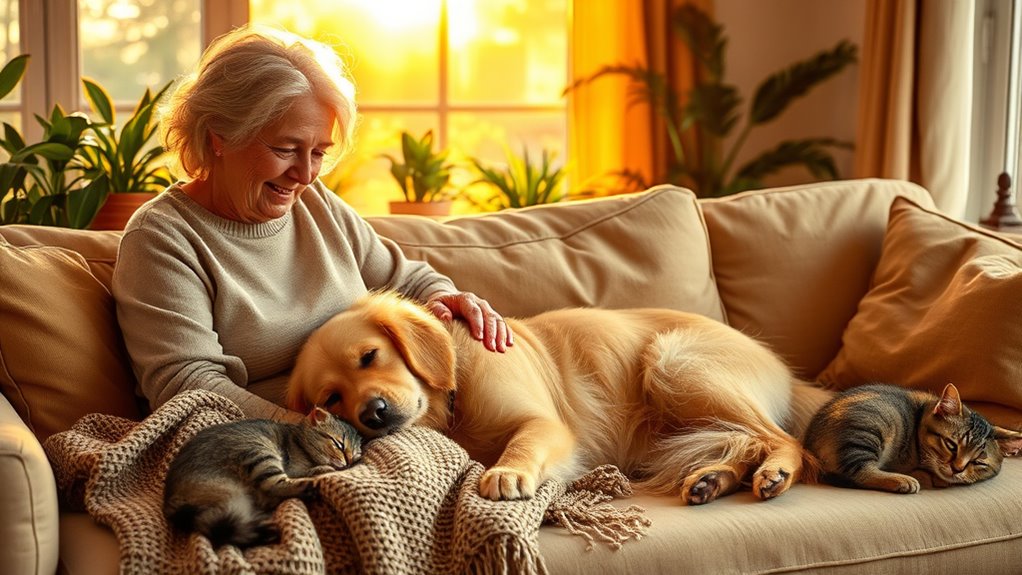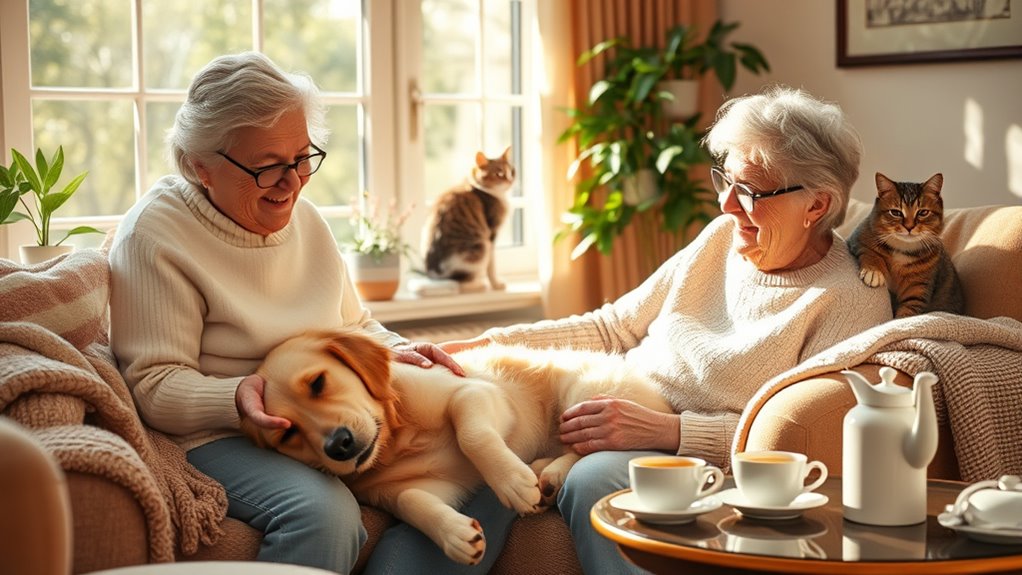Having furry friends at home can boost your mood, lower stress, and improve your overall wellbeing. Spending time with pets releases feel-good chemicals like oxytocin and serotonin, making you happier and more relaxed. Pets respond to your emotions, strengthening bonds and providing comfort. Proper care, routines, and a calming environment enhance these benefits. Keep exploring to discover simple ways to turn your home into a therapeutic haven with your furry companions.
Key Takeaways
- Spending time with pets releases mood-enhancing hormones like oxytocin and serotonin, boosting emotional wellbeing.
- Pets provide calming companionship and routines that reduce stress and anxiety in the home environment.
- Regular physical activities with pets improve cardiovascular health for both owner and animal.
- Creating a peaceful, well-designed space enhances therapeutic interactions and relaxation.
- Choosing the right pet and maintaining proper care fosters strong emotional bonds and long-term wellbeing.
The Science Behind Pet-Driven Happiness

Research shows that spending time with pets triggers the release of feel-good chemicals like oxytocin and serotonin in your brain. This boost in happiness isn’t accidental; it’s rooted in animal cognition, where your pet responds to your emotions and cues, strengthening your bond. When you care for your pet’s needs, including their pet nutrition, you foster a healthier relationship that enhances mutual happiness. Understanding how animals think and perceive their environment helps you connect more deeply, making interactions more meaningful. As your pet recognizes your affection and attention, their responses reinforce your positive feelings. This cycle of mutual engagement and proper nutrition supports not only their well-being but also elevates your mood, creating a powerful, scientifically backed pathway to happiness. Additionally, contrast ratio plays a role in how clearly your pet’s environment appears, influencing their comfort and your ability to observe their behavior.
How Pets Reduce Stress and Anxiety

Pets naturally help lower stress and anxiety by providing comforting companionship and a calming presence. When you spend time pet grooming, it creates a soothing routine that relaxes both you and your pet. Regular grooming sessions can reduce tension, making you feel more at ease. Additionally, pet training helps establish clear boundaries and improves communication, which minimizes behavioral frustrations that can cause stress. As you teach your pet new skills, you build confidence and trust, leading to a more harmonious relationship. These activities encourage mindfulness, helping you stay present and focused, reducing anxious thoughts. Overall, caring for your pet through grooming and training fosters a peaceful environment, considerably easing your stress and promoting emotional well-being. Incorporating unique and wicked planters into your space can also enhance your environment, creating a more calming atmosphere.
Physical Health Benefits of Having Furry Friends

Having a furry companion can substantially boost your physical health by encouraging you to stay active and engaged. Regular walks and playtime with your pet increase your daily exercise, helping improve cardiovascular health and boost stamina. Maintaining pet nutrition is essential, as a healthy diet supports your pet’s vitality and reduces health issues that could impact you later. Additionally, sticking to pet grooming routines keeps your pet’s coat clean and free of parasites, preventing infections that could affect your health. These routines also promote your physical activity, as brushing and bathing require movement. Taking care of your pet’s health not only benefits them but also keeps you moving and attentive to their needs, ultimately contributing to your overall physical wellbeing. Incorporating mindful routines into your pet care can further enhance your mental and emotional connection, leading to a happier, healthier life for both of you.
Building Stronger Emotional Connections Through Pets

Building stronger emotional connections with your pet starts with trusting and bonding with them daily. When you interact consistently, it encourages both of you to develop deeper emotional support and understanding. These ongoing moments strengthen your relationship and create a comforting, reliable presence in your life. Incorporating consistent skincare routines like using eye patches can also promote feelings of self-care and well-being, further enhancing your emotional resilience.
Enhancing Trust and Bonding
When you spend quality time with your pet, you create opportunities to develop pet trust and deepen your emotional connection. Engaging in bonding activities like gentle grooming, playing, or simply cuddling helps your pet feel safe and valued. Consistent routines and calm interactions reinforce reliability, making your pet more comfortable around you. These shared experiences foster mutual understanding and build a foundation of trust. As your pet begins to anticipate your presence positively, your bond strengthens naturally. Remember, patience and attentiveness are key—trust develops over time through gentle, caring interactions. Incorporating positive reinforcement techniques can further enhance your pet’s trust and cooperation. Strengthening this emotional connection not only enhances your pet’s wellbeing but also enriches your own, creating a more fulfilling companionship.
Encouraging Daily Interaction
To strengthen your bond with your pet, try to incorporate daily interactions into your routine. Consistent pet care and regular engagement help build trust and deepen your emotional connection. Set aside time each day for activities like feeding, play, or gentle petting. These routines provide stability and reassurance for your furry friend, making them feel secure and loved. Incorporating proper equipment such as safe toys and grooming tools can also enhance your bonding experience.
Fostering Emotional Support
Ever wondered how your pet can become a true source of emotional support? Pet companionship naturally fosters emotional bonding, helping you feel less alone during tough times. When you spend quality time with your furry friend, you build trust and deepen your connection. This emotional support goes beyond simple comfort; it creates a safe space where you can express your feelings openly. Pets respond to your moods, providing reassurance when you’re stressed or anxious. By nurturing this bond through cuddles, play, or quiet moments, you strengthen your relationship and enhance your wellbeing. Over time, these interactions transform your pet into an essential source of emotional stability, making your home a more nurturing environment for both of you. Additionally, understanding that pets can provide emotional support, similar to therapeutic interventions, highlights their vital role in mental health.
Tips for Creating a Therapeutic Environment at Home

Creating a calming environment at home can make your pet therapy sessions more effective. Focus on setting up cozy pet spaces and maintaining a peaceful atmosphere. Small adjustments can make a big difference in how your pet and you feel during these moments. Incorporating mindful decluttering strategies can help reduce stress and create a more serene space for both you and your furry friends.
Cozy Pet Spaces
Designing a cozy pet space at home involves more than just placing a bed in a corner; it’s about crafting an environment that feels safe and inviting for your furry friend. Start by selecting a quiet spot where your pet can relax undisturbed. Next, focus on comfort and health with these essentials:
- Use soft, washable bedding that supports proper pet grooming and hygiene.
- Incorporate items like blankets or toys that promote mental stimulation and comfort.
- Ensure the space is well-ventilated, and keep pet nutrition and hydration nearby for easy access.
- Utilize password strength indicators to protect your online accounts related to pet care, ensuring your digital security while managing your pet’s needs.
Creating this environment helps your pet feel secure, reduces stress, and promotes overall wellbeing, strengthening your bond and supporting a calming atmosphere at home.
Calm Atmosphere Tips
To foster a calming environment at home, focus on minimizing noise and visual distractions that can overstimulate your pet. Use soft lighting, keep the space clutter-free, and play calming music to reduce stress. Gentle pet massages can also promote relaxation, helping your furry friend feel secure. Creating a peaceful atmosphere encourages your pet to unwind, making pet therapy sessions more effective. Consider these tips to enhance tranquility:
| Tip | Benefit |
|---|---|
| Play calming music | Soothes nerves and reduces anxiety |
| Use gentle pet massage | Promotes relaxation and bonding |
| Minimize loud noises | Prevents overstimulation |
Implementing these strategies helps your pet feel safe and calm, maximizing the therapeutic benefits of your home environment.
Choosing the Right Pet for Your Wellbeing Goals

Choosing the right pet depends on your specific wellbeing goals and lifestyle. To find the best match, consider these factors:
- Activity Level: If you seek stress relief and enjoy outdoor activities, a dog might be ideal, but remember pet training is essential for good behavior.
- Space and Time: For smaller spaces or limited time, a cat or a calm rabbit can provide companionship without demanding extensive attention.
- Commitment: Pet adoption is a meaningful way to give a home to an animal in need, but ensure you’re prepared for long-term care and training.
- Animal types can vary greatly in their care requirements and emotional benefits, so researching specific animal types can help you make an informed decision.
Frequently Asked Questions
How Do Pet Therapy Programs Differ From Owning a Pet at Home?
Pet therapy programs differ from owning a pet at home because they involve professionally trained animals and handlers who facilitate structured activities designed to promote your wellbeing. While owning a pet offers companionship, therapy programs focus on specific interventions, such as guided interactions or emotional support, under expert supervision. This guarantees safe, targeted benefits, and helps you gain the therapeutic advantages of animals without the responsibilities of full-time pet ownership.
Can Pets Help With Specific Mental Health Conditions Like Depression?
Pets can profoundly help with mental health conditions like depression by providing emotional support and boosting your mood. They offer companionship, reduce feelings of loneliness, and create a sense of purpose. When you interact with your pet, your brain releases mood-enhancing chemicals like serotonin and dopamine. This natural stimulation can help alleviate depressive symptoms, making your daily life more manageable and improving overall emotional well-being through their unconditional love and presence.
What Are the Safety Considerations When Introducing a New Pet Into the Home?
When introducing a new pet, you should prioritize pet safety by following quarantine protocols to prevent illness. Make certain your new furry friend gets a thorough health check and keeps apart from current pets initially. Supervise interactions closely, gradually increasing contact as you observe safe behavior. Always provide a safe, comfortable space for the new pet, and be patient. These steps help protect both your existing pets and new family member.
How Do Pets Influence Social Interactions and Loneliness?
You might think pets only provide companionship, but they actually boost your social interactions and reduce loneliness through animal assisted therapy. When you spend time with your furry friends, you naturally engage more with others, fostering social bonding. Pets serve as social catalysts, making conversations easier and encouraging community involvement. Their presence helps bridge gaps, making you feel less isolated and more connected with those around you.
Are There Age Restrictions or Considerations for Different Types of Pets?
When considering age restrictions and pet suitability, you should think about your lifestyle and the pet’s needs. Young children may benefit from smaller, gentle pets like guinea pigs, while older adults might prefer low-maintenance animals such as cats or certain dogs. Always assess safety, activity level, and care requirements to guarantee your pet fits your age and ability. Choosing appropriately supports both your wellbeing and your pet’s happiness.
Conclusion
Think of your home as a garden, and your furry friends as the sunlight and water that help it thrive. With their gentle presence, they nurture your wellbeing, turning everyday moments into blooming opportunities for happiness. Just as a garden flourishes with care, so does your spirit. Embrace the companionship of your pets, and watch your life blossom into a vibrant, joyful sanctuary where stress melts away and connection flourishes.









